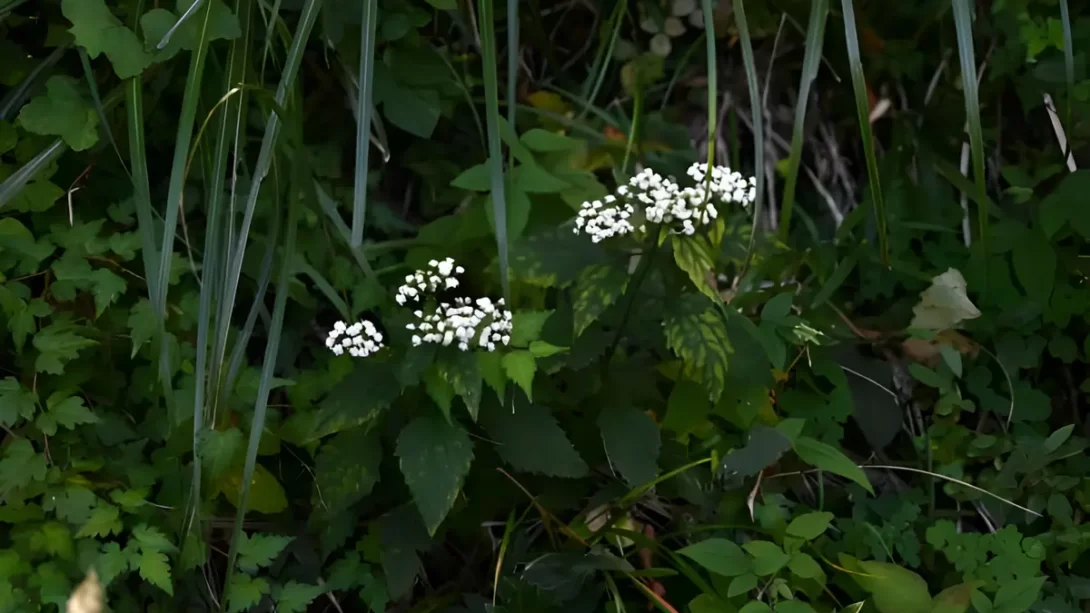White Snakeroot (Ageratina altissima), a common plant in North America, is often recognized for its clusters of small, white flowers. While it adds beauty to natural landscapes, there is growing concern about its toxicity, particularly the risks associated with touching the plant. This article aims to explore the toxicity of White Snakeroot, focusing on whether it is poisonous to touch and the precautions that should be taken when handling it.
White Snakeroot
White Snakeroot is a perennial herb typically found in woodlands, thickets, and along stream banks. It grows about one to three feet tall and blooms from late summer to fall. The plant is characterized by its toothed leaves and fluffy, white flower clusters. Historically, White Snakeroot has been known for its role in “milk sickness,” a condition affecting people who consumed milk or meat from cattle that had grazed on the plant. This historical context underscores the importance of understanding its toxic properties.
The Toxic Nature of White Snakeroot
The primary toxic compound in White Snakeroot is tremetol, a mixture of alcohol compounds. When ingested, tremetol can cause severe illness in both humans and animals, particularly cattle. The infamous “milk sickness”, which led to numerous deaths in the early 19th century, was predominantly due to the consumption of dairy products from cows that had ingested White Snakeroot. The presence of this toxin raises questions about the safety of coming into contact with the plant and whether its toxicity can affect humans through skin exposure.
Toxicity Through Touch
The concern about toxicity through skin contact with White Snakeroot is a subject of particular interest. Unlike plants like poison ivy, poison oak, or poison sumac, which are known to cause dermatitis upon contact, White Snakeroot’s primary mode of toxicity is through ingestion. There is limited evidence to suggest that touching White Snakeroot can cause a toxic reaction in humans. However, sensitivity to plants can vary greatly among individuals, and it’s important to consider that some people might experience mild skin irritation when handling certain plant species.
Symptoms of White Snakeroot Poisoning
While direct skin contact with White Snakeroot may not be highly toxic, understanding the symptoms of its ingestion is crucial, as accidental exposure can occur. Symptoms of poisoning from White Snakeroot ingestion include vomiting, nausea, weakness, abdominal pain, and in severe cases, death. These symptoms result from the tremetol’s impact on the liver and digestive system. In contrast, symptoms from skin contact, if any, are likely to be limited to mild skin irritation or rash.
Handling and Safety Precautions
Given the potential risks associated with White Snakeroot, especially through ingestion, it’s advisable to exercise caution when handling this plant. If you are working in areas where White Snakeroot is present, wearing gloves and long sleeves can minimize skin contact. This is particularly important for individuals with sensitive skin or known allergies to plants. Washing hands thoroughly after handling any part of the plant is a good practice. Additionally, ensuring that children and pets avoid contact with White Snakeroot is crucial for safety, as they may be more prone to accidental ingestion.
First Aid and Medical Response
In the event of accidental ingestion of White Snakeroot, immediate medical attention is necessary. If someone suspects they have ingested the plant, it’s important to not induce vomiting unless advised by a medical professional. Instead, they should be taken to a healthcare facility as soon as possible. For skin irritation that might arise after handling the plant, washing the affected area with soap and water is recommended. If the irritation persists or if any symptoms of discomfort occur, seeking medical advice is advisable. Keeping a sample of the plant for identification can be helpful for healthcare providers in administering the appropriate treatment.
Awareness and Education
Educating oneself and others about the potential dangers of White Snakeroot, especially in areas where the plant is prevalent, is key to preventing accidental poisoning. This includes understanding the appearance of the plant, being aware of the symptoms of tremetol poisoning, and knowing how to respond in case of ingestion. Community education programs, especially in rural and farming areas, can play a significant role in preventing incidents related to White Snakeroot.
Conclusion
In conclusion, while White Snakeroot is not typically considered toxic through skin contact, its potential for severe toxicity upon ingestion should not be underestimated. Handling the plant with caution, using protective clothing, and washing hands afterward are sensible precautions. Understanding the risks associated with White Snakeroot, recognizing its symptoms, and knowing how to respond in case of accidental ingestion are crucial for ensuring safety, especially in areas where the plant is common. Through awareness and careful handling, the risks posed by White Snakeroot can be effectively managed.
First Aid and Medical Response
In the event of accidental ingestion of White Snakeroot, immediate medical attention is necessary. If someone suspects they have ingested the plant, it’s important to not induce vomiting unless advised by a medical professional. Instead, they should be taken to a healthcare facility as soon as possible. For skin irritation that might arise after handling the plant, washing the affected area with soap and water is recommended. If the irritation persists or if any symptoms of discomfort occur, seeking medical advice is advisable. Keeping a sample of the plant for identification can be helpful for healthcare providers in administering the appropriate treatment.
Awareness and Education
Educating oneself and others about the potential dangers of White Snakeroot, especially in areas where the plant is prevalent, is key to preventing accidental poisoning. This includes understanding the appearance of the plant, being aware of the symptoms of tremetol poisoning, and knowing how to respond in case of ingestion. Community education programs, especially in rural and farming areas, can play a significant role in preventing incidents related to White Snakeroot.
Conclusion
In conclusion, while White Snakeroot is not typically considered toxic through skin contact, its potential for severe toxicity upon ingestion should not be underestimated. Handling the plant with caution, using protective clothing, and washing hands afterward are sensible precautions. Understanding the risks associated with White Snakeroot, recognizing its symptoms, and knowing how to respond in case of accidental ingestion are crucial for ensuring safety, especially in areas where the plant is common. Through awareness and careful handling, the risks posed by White Snakeroot can be effectively managed.




